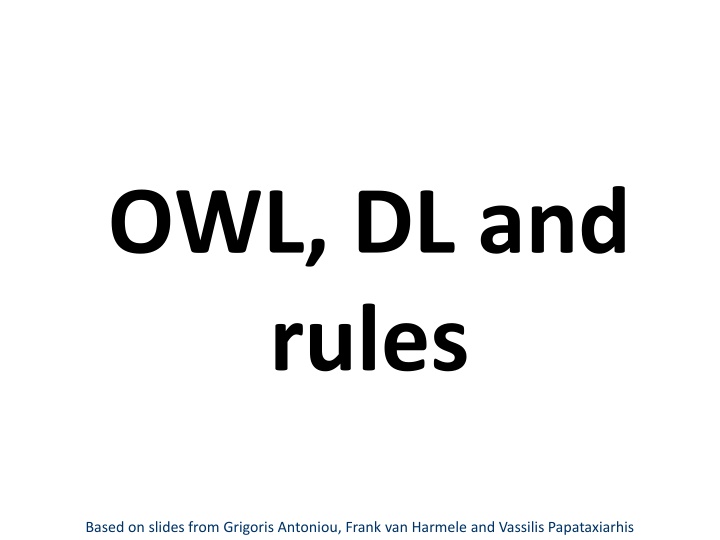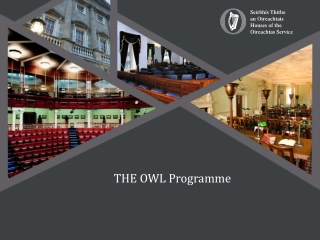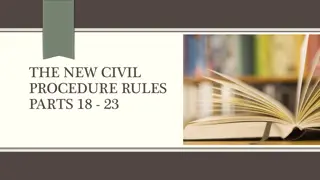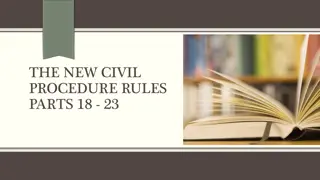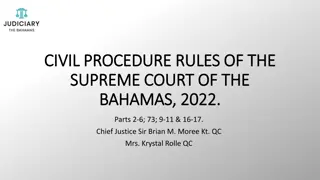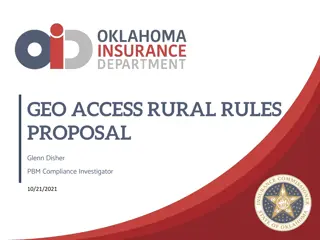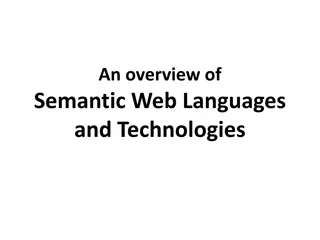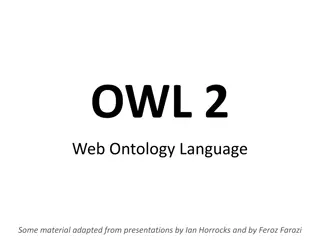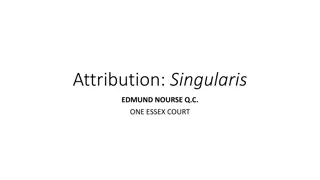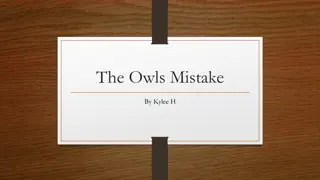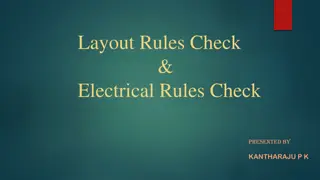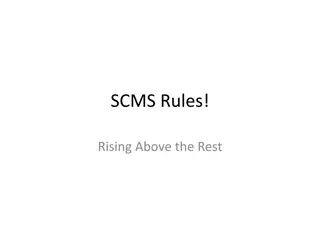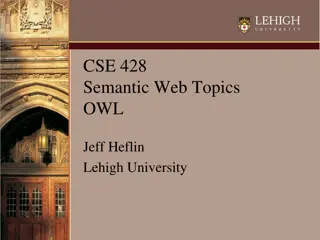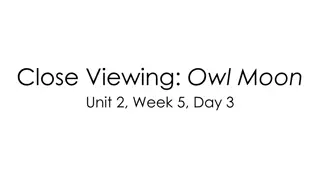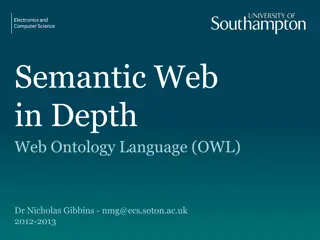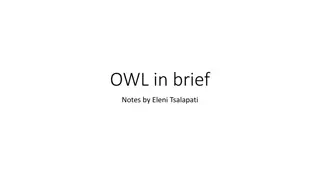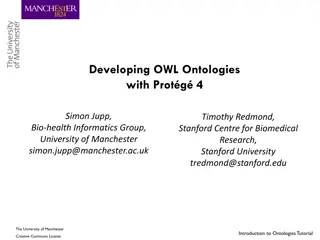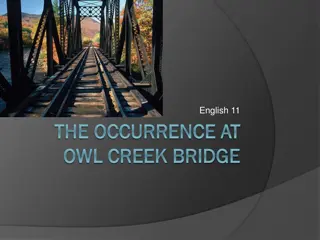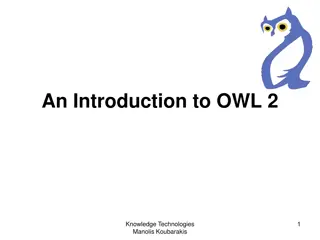OWL, DL and rules
In the realm of Semantic Web, the interaction between OWL, DL, and rules plays a crucial role in representing and reasoning with knowledge. This involves exploring the challenges of incorporating rules into OWL and examining key approaches such as SWRL and RIF. Understanding the logic foundations like OWL Full, OWL-DL, and N3 rules is essential for effective modeling. The discussions also delve into the significance of structure alongside rules in ontology development. Delve deeper into the intricacies of integrating description logics and Horn logic, showcasing the distinct features and limitations of each. Explore SWRL as a bridge between DL and horn logic, highlighting its attributes and limitations. Uncover the nuances of combining unary predicates and binary properties in OWL classes.
Uploaded on Mar 05, 2025 | 0 Views
Download Presentation

Please find below an Image/Link to download the presentation.
The content on the website is provided AS IS for your information and personal use only. It may not be sold, licensed, or shared on other websites without obtaining consent from the author.If you encounter any issues during the download, it is possible that the publisher has removed the file from their server.
You are allowed to download the files provided on this website for personal or commercial use, subject to the condition that they are used lawfully. All files are the property of their respective owners.
The content on the website is provided AS IS for your information and personal use only. It may not be sold, licensed, or shared on other websites without obtaining consent from the author.
E N D
Presentation Transcript
OWL, DL and rules Based on slides from Grigoris Antoniou, Frank van Harmele and Vassilis Papataxiarhis
OWL and Rules Rule based systems are an important and useful way to represent and reason with knowledge Adding rules to OWL has proved to be fraught with problems We ll look at the underlying issues and two approaches SWRL: failed standard that ishas become widely used RIF: a successful standard that s not yet widely used
Semantic Web and Logic The Semantic Web is grounded in logic But what logic? OWL Full = Classical first order logic (FOL) OWL-DL = Description logic N3 rules ~= logic programming (LP) rules SWRL ~= DL + LP Other choices are possible, e.g., default logic, fuzzy logic, probabilistic logics, How do these fit together and what are the consequences
We need both structure and rules OWL s ontologies based on DL (and thus in FOL) - The Web is an open environment - Reusability / interoperability - An ontology is a model easy to understand Many rule systems based on logic programming - To achieve decidability, ontology languages don t offer the expressiveness we want. Rules do it well - Efficient reasoning support already exists - Rules are well-known and often more intuitive
Description Logics vs. Horn Logic Neither is a subset of the other Impossible in OWL DL: people who study & live in same city are local students, Easily done with a a rule studiesAt(X,U), loc(U,L), lives(X,L) localStud(X) Impossible in horn rules: every person is either a man or a woman Easily done in OWL DL: :Person owl:disjointUnionOf (:Man :Woman).
SWRL: Semantic Web Rule Language SWRL is the union of DL and horn logic + many built-in functions (e.g., for math) Submitted to the W3C in 2004, but failed to become a recommendation W3C pursued a more general solution: RIF Problem: full SWRL specification leads to undecidability in reasoning SWRL is well specified and subsets are widely supported (e.g., in Pellet, HermiT)
SWRL OWL classes are unary predicates, properties are binary ones Person(?p) ^ sibling(?p,?s) ^ Man(?s) brother(?p,?s) As in Prolog, bulit-ins can be booleans or do a computation and unify the result to a variable swrlb:greaterThan(?age2, ?age1) # age2>age1 swrlb:subtract(?n1,?n2,?diff) # diff=n1-n2 SWRL predicates for OWL axioms and data tests differentFrom(?x, ?y), sameAs(?x, ?y), xsd:int(?x), [3, 4, 5](?x),
The Essence of SWRL Combines OWL DL (and thus OWL Lite) with function-free Horn logic Thus it allows Horn-like rules to be combined with OWL DL ontologies
Rules in SWRL B1, . . . , Bn A1, . . . , Am A1, . . . , Am, B1, . . . , Bn have one of the forms: C(x) P(x,y) sameAs(x,y) differentFrom(x,y) where C is an OWL description, P is an OWL property, and x,y are variables, OWL individuals or OWL data values
SWRL Built-Ins SWRL defines a set of built-in predicate that allow for comparisons, math evaluation, string operations and more See here for the complete list Examples Person(?p), hasAge(?p, ?age), swrlb:greaterThan(?age, 18) -> Adult(?p) Person(?p), bornOnDate(?p, ?date), xsd:date(?date), swrlb:date(?date, ?year, ?month, ?day, ?timezone) -> bornInYear(?p, ?year) Some reasoners (e.g., Pellet) allow you to define new built-ins in Java
Drawbacks of SWRL Main source of complexity: arbitrary OWL expressions, such as restrictions, can appear in the head or body of a rule Adds significant expressive power to OWL, but causes undecidability there is no inference engine that draws exactly the same conclusions as the SWRL semantics
SWRL Sublanguages SWRL adds the expressivity of DLs and function-free rules One challenge: identify sublanguages of SWRL with right balance between expressivity and computational viability A candidate OWL DL + DL-safe rules every variable must appear in a non- description logic atom in the rule body
DL-safe rules Standard reasoners support only DL-safe rules Rule variables bind only to known individuals (i.e., owl2 owl:NamedIndividual) Example :Vehicle(?v) ^ :Motor(?m) ^ :hasMotor(?v,?m) -> :MotorVehicle(?v) Where :Car = :Vehicle and some hasMotor Motor :x a :Car The reasoner will not bind ?m to a motor since it is not a known individual
Protg 5 had SWRLTab Add/edit rules and optionally run a separate rules engine
SWRL limitations SWRL rules do not support many useful features of of some rule-based systems Default reasoning Rule priorities Negation as failure (e.g., for closed-world semantics) Data structures The limitations gave rise to RIF
Summary Horn logic is a subset of predicate logic that allows efficient reasoning, orthogonal to description logics Horn logic is the basis of monotonic rules DLP and SWRL are two important ways of combining OWL with Horn rules. DLP is essentially the intersection of OWL and Horn logic SWRL is a much richer language
Summary (2) Nonmonotonic rules are useful in situations where the available information is incomplete They are rules that may be overridden by contrary evidence Priorities are sometimes used to resolve some conflicts between rules Representation XML-like languages is straightforward
